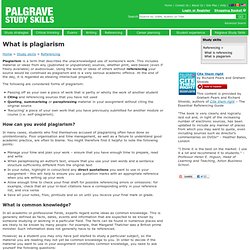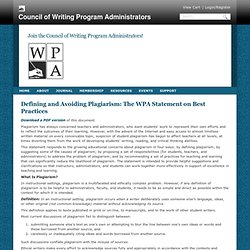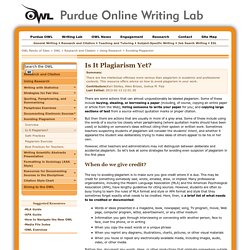

Overview — Plagiarism.org - Best Practices for Ensuring Originality in Written Work. The Anti Plagiarism Game Show Cite is Right! When do you have to cite your sources? Paraphrasing tool. Plagiarismpracticeworksheet_000.pdf. Plagurism poster. Skills4Study.com: Study Skills - What is Plagiarism. Cite them right by Richard Pears and Graham Shields This content is provided by Graham Pears and Richard Shields, authors of Cite them right – The Essential Referencing Guide "The book is very clearly and logically laid out and, in light of the increasing number of electronic sources, has been updated to include any manner of places from which you may want to quote, even including sources such as director's commentaries on DVDs!

" - Heather Bates, London "I think it is the best on the market. I use it a lot and recommend it to students. " - Professor Helen E. Home > Study skills > Referencing Plagiarism is a term that describes the unacknowledged use of someone's work. The following are considered forms of plagiarism: How can you avoid plagiarism? In many cases, students who find themselves accused of plagiarising often have done so unintentionally. What is common knowledge? In all academic or professional fields, experts regard some ideas as common knowledge. Turnitin : Results : Plagiarism Spectrum. What is Plagiarism? — Plagiarism.org - Best Practices for Ensuring Originality in Written Work. Many people think of plagiarism as copying another's work or borrowing someone else's original ideas.

But terms like "copying" and "borrowing" can disguise the seriousness of the offense: According to the Merriam-Webster Online Dictionary, to "plagiarize" means to steal and pass off (the ideas or words of another) as one's ownto use (another's production) without crediting the sourceto commit literary theftto present as new and original an idea or product derived from an existing source. What is Plagiarism? Acceptable Use or Plagiarism, Quiz 1. Is it plagiarism quiz. Academic Writing: A Handbook for International Students - Plagiarism Quiz. University DiMennna-Nyselius Library Quiz: You Be the Judge. Academic Writing: A Handbook for International Students. Complete_resources. Childnet_plagiarism_PowerPoint. Avoiding plagiarism mastering the art of scholarship. Defining and Avoiding Plagiarism: The WPA Statement on Best Practices. Download a PDF version of this document.

Plagiarism has always concerned teachers and administrators, who want students’ work to represent their own efforts and to reflect the outcomes of their learning. However, with the advent of the Internet and easy access to almost limitless written material on every conceivable topic, suspicion of student plagiarism has begun to affect teachers at all levels, at times diverting them from the work of developing students’ writing, reading, and critical thinking abilities. Plagiarism. What is Plagiarism and Why is it Important?

In college courses, we are continually engaged with other people’s ideas: we read them in texts, hear them in lecture, discuss them in class, and incorporate them into our own writing. As a result, it is very important that we give credit where it is due. Plagiarism is using others’ ideas and words without clearly acknowledging the source of that information.
How Can Students Avoid Plagiarism? To avoid plagiarism, you must give credit whenever you use another person’s idea, opinion, or theory; any facts, statistics, graphs, drawings—any pieces of information—that are not common knowledge; quotations of another person’s actual spoken or written words; or paraphrase of another person’s spoken or written words. These guidelines are taken from the Code of Student Rights, Responsibilities, and Conduct. How to Recognize Unacceptable and Acceptable Paraphrases. Plagiarism_Infograph. 2013-07-25_National%20plagiarism%20strategy_a%20case%20study_GB_EN_v4. Plagiarism2012. 2009-12-24-plagiarism-parents. Childnet_plagiarism_planning_sheet. Understanding Plagiarism - revised January 2014. Childnet_plagiarism_Lesson_Plan. Avoiding Plagiarism. Summary: There are few intellectual offenses more serious than plagiarism in academic and professional contexts.

This resource offers advice on how to avoid plagiarism in your work. Contributors:Karl Stolley, Allen Brizee, Joshua M. PaizLast Edited: 2013-02-13 12:01:30 There are some actions that can almost unquestionably be labeled plagiarism. But then there are actions that are usually in more of a gray area. However, other teachers and administrators may not distinguish between deliberate and accidental plagiarism. When do we give credit? The key to avoiding plagiarism is to make sure you give credit where it is due. Bottom line, document any words, ideas, or other productions that originate somewhere outside of you. There are, of course, certain things that do not need documentation or credit, including: